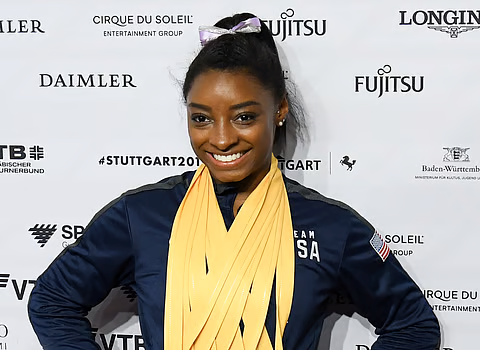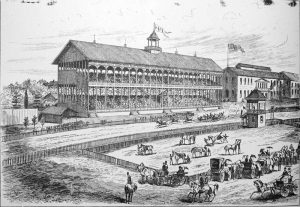The athletic world considers Simone Biles the greatest gymnast of all time. Biles is commonly called the GOAT because of what everyone thinks of her.1 To many Americans, she was known as the woman who continued to define gravity and define record books. The audience of people who watched her perform cheered and held their breath during every trick and flip she did. All the sports writers and commentators spoke so highly of Simone Biles and labeled her the “Greatest Gymnast of all time.” But with all the fame, between all the medals and interviews, Simone wasn’t just the “Greatest Gymnast of all time”; she was also just like us. She was human.

In 2020, the whole world stopped due to a deadly virus known as COVID-19. This meant the highly anticipated 2020 Tokyo Olympics were also postponed for the first time in history. Simone and all the other athletes handled this adversity well. She continued to train and was determined to come into these Olympics with a smile on her face, like she always does. She was training harder than ever before and told everyone that she wanted to be even better by the time the Tokyo Olympics were allowed to continue. But the other side of the story was more complicated and unknown. The COVID-19 pandemic kept the world quiet. The Tokyo games required strict COVID-19 measures and were held with no in-person audience.2 No filled arenas with roaring crowds, no teammates gathering after practice, no normal day. Her constant training felt endless and exhausting. Expectations felt heavier, and the weight on her shoulders kept pushing her farther down. She wasn’t just expected to win and try her best; she was expected to win it all and prove to the world that she was the greatest of all time.
She tried to disguise the pressure as motivation and to switch her mindset into believing that she is the “GOAT” and that she must prove that she deserves that label. She tries to convince herself that she has to be this superhuman that everyone sees her as. She feels as if she cannot fail. She has to make her teammates and her country proud of her. She has to make survivors of mental and physical abuse proud of her. She has to make her younger self proud of her. Simone Biles says, “This Olympic Games, I wanted it to be for myself, but I came in, and I felt like I was still doing it for other people. It hurts my heart that doing what I love has been kind of taken away from me to please other people.”3 And the longer she pushed the thoughts that she had lingering, the louder they roared at her, in her mind.
By the time the long-awaited Tokyo Olympics officially began in 2021, the world was desperate for the magic to be felt throughout the games and the arena. All eyes turned to someone they knew would bring the spark to the world again, Simone Biles. Even before she set foot in the competition arena, there were many cameras and microphones waiting for her for many interviews and many articles. Even the gymnasts from other countries whispered that they just wanted to see her defy gravity in real life. The Olympics seemed like it had predicted gold for Team USA before the first competitions were even set to start. Simone smiled at interviews, waved to the fans, and tied her chalk-covered grips the same way she always did. But inside her body and mind, the small feeling she had before began to eat her alive. During practice in Tokyo, she began making simple, rookie mistakes, such as stepping out on landings, low confidence, and hesitation in the air. Coaches assumed she was just warming up or getting used to the environment, what athletes are known to do. No one knew anything was wrong. None of the fans, none of the officials, no one. But Simone knew it. Deep down, she knew her mind and her body were not working cohesively. The mind and body work together is an important step in the gymnastics world. Without that needed connection, there is a disaster waiting to happen.
On the day of the team final, the arena was bright, cold with blazing air coming from the vents, and unusually quiet without full crowds screaming their names. Simone’s teammates Jordan Chiles, Suni Lee, and Grace McCallum, stood beside her, smiling, nervous, but overall, very excited to compete. They respected Simone, looked up to her, and loved her. She was their leader. She was the team’s big sister, and she was taking on this big role. Simone wrapped her hands around the vaulting table one last time before stepping back to salute the judges and to start her routine. She shook her arms to loosen her shoulders, took a deep breath, and sprinted. As soon as she sprinted, she was known as Simone Biles, the most decorated gymnast of all time. The second she took off from the vault, she was lost mid-air and all her medals and hard work went slowly down the drain. She had meant to do an Amanar vault with two and a half twists. Instead, her mind blanked, and her body turned only once. When she landed, she stumbled and nearly fell to the floor, landing on her knees. The once quiet arena was filled with gasps from every athlete, every coach, every judge. Her teammates froze in awe, and her coaches stared from afar, wide-eyed, and did not know what to do next. Everyone watching saw a rare mistake for someone who is as advanced as her. But Simone knew it wasn’t just a mistake. It was a case of the Twisties, which is a terrifying mental block where the brain loses track of the body in mid-air. For any gymnast, it was dangerous. For Simone, this case of the Twisties can be very deadly. Biles twists across all of her disciplines, and it is usually one of her numerous strengths.4 Her skills were miles above the competition, and these difficult skills can be dangerous to even attempt while battling the Twisties. She tried to smile through the pain and the doubts as she walked off the floor, but the tears arrived before she had even reached her coach. Her hands were trembling out of fear, not knowing what this meant for her and her upcoming competition. Her breath wouldn’t slow down, and she felt as if everything she had trained for suddenly felt impossible.
The big decision that came next would leave the world speechless. A few minutes after her dangerous vault failed, Simone pulled away from competing in the team final on the highest stage, days before they were set to compete. At the time, Biles explained her withdrawal by saying she had â[euro]oethe twisties, â[euro] a term used in gymnastics to indicate that the athlete has lost spatial awareness in the air.5 Her coaches stood quietly beside her, but they had her back in this big decision. Her doctor continued to check her. The reporters that saw her leave the competition floor saw her shoulders trembling and her hands shaking with doubts and fear. It didn’t feel real. The world was stunned and didn’t know how the Olympic games could even go forward after hearing this news. She wasn’t injured, at least not physically. But something inside her was broken in a way she couldn’t explain to the world. She had always been known as the main fighter of this young USA Team. She was the undisputed champion. The one who pushed through everything and anything that got in her way of gold. And now she was walking away. She was giving up on her teammates, her coaches, and her country.
As she sat in the back hallway of the arena, her teammates rushed over with tears in their eyes. Instead of being angry or upset at her decision, they just hugged her. They told her that although she was not competing with them anymore, that she was still a huge part of their team and they needed her leadership any way they could get. They expressed how proud they were of her and how much they loved her, on and off the mat. When the USA Team finished and later won silver at the 2020 Tokyo Olympics, Simone stood proudly with them on the podium. The cameras zoomed in on the whole team, and Simone showed the biggest smile of the whole team. Some people on social media called her brave, while others called out her weakness. Commentators argued on and on, while on live television, about whether she had let her country down or made the best decision for herself. Everyone had all these different opinions about her. But she didn’t let that affect her. She knew she had just saved herself. She says to all those who are doubting her that “For anyone saying I quit, I didn’t quit, my mind and body are simply not in sync as you can see here.”6
Instead of resting, Simone spent the next days of the competition being swarmed with many cameras, microphones, and numerous questions: Why did you quit? Are you mentally strong enough to get back to leading this team? How do you feel that you let down your country? Do you still consider yourself the GOAT? Simone tried to explain the best that she could to all of the reporters. She showed how proud she was of her teammates by saying, “But today it was like, you know what, I don’t want to do something stupid, get hurt. It’s not worth it, especially when you have three amazing athletes who can step up to the plate and do it. Not worth it.”7
She talked about her mental health and mental health for all athletes. She talked about how dangerous gymnastics becomes when the mind and body are not on the same page with each other. She also expressed that some people listened to what she had to say about her journey, while others didn’t. Every night, tears filled up the pillows in her room, not because she regretted withdrawing, but because she felt so alone, in her own mind and in her own body. The world expected superhuman strength from her but, for the first time, she felt human. All the emotions and all the pressure at once made her feel like she was at rock bottom. Throughout those long nights and what felt like endless nights, her teammates checked on her. Her coaches continued to remind her that the medals and the Olympics games were not as important as her health, mentally and physically. She talked to her family, her therapy team, and her closest friends during this hard time for her, and they reminded her of something she had forgotten. They told her that she was still human at the end of the day and making this big, uneasy decision was the right one for her at the end of the day. Still, she asked herself if she had made the right choice or not. She wondered how the sports world would now look at her after being a “quitter.” She thought of all the young gymnasts that were constantly looking up to her and what they now see her as. One morning, after she had withdrawn from the competition, she opened her phone and saw something she would never have expected. She saw messages blowing up her phone from every social media app she had, from every athlete she knew. She saw spam mail from every young athlete that looked up to her. They all sent her the same message. They told her that she made it okay to ask for help if you needed it. A lot of athletes tend to shove their mental health down to keep pursuing their sports. They allow themselves to ignore the problems, and this later catches up to them, which leads to severe depression and, in extreme cases, even suicide. Suddenly, something shifted in her mind. Maybe she hadn’t lost the competition. Maybe she had won in something much bigger in the world that no gold medal ever could give her. She explains the new empowerment that she felt by saying “it brings a bigger light on mental health and we’re not just athletes; we are people at the end of the day, so we have to focus on that.”8
A few days before the balance beam final that Simone wasn’t planning on participating in, Simone felt something change, a spark came back. In practice, she tried a simple dismount, which was a double pike instead of her usual twisting skill. The double pike wasn’t her most difficult skill by any means. But it was safe. It was what she could manage without risking her life, while still performing for her team and her country. That night after practice, she decided that she wanted to have a chance to compete in these Olympic Games. Not for the fans, her teammates, or all the people who doubted her. She wanted a chance to compete for herself. When she walked into the arena for the beam final, the pressure was still there, but it wasn’t tearing her down anymore. Her heart was beating rapidly but not out of fear of failure, but out of pride in herself. She saluted the judges, climbed onto the beam, and began her routine. Her movements were calm. She was focused and controlled while knowing that every move, every turn, mattered. When she landed her final non-twisting dismount, she smiled. She smiled because she knew she had done that routine for herself. She didn’t care about the placement or the difficulty of skill. She made herself proud and that was all the gold she needed in her life. Her coaches were just as proud of her saying “Getting mental health help” didn’t stop (Biles) from continuing her journey to cement her greatness, but that was a necessary part of her journey.” 9 When the scores came in, she realized she had completed the impossible. She had won a bronze medal. She broke down in tears on the podium. But winning a bronze medal at the Olympics wasn’t what made her cry. It was the roaring of cheering that she was getting from every single voice in that arena. They weren’t cheering because she had dominated the way she used to, but because she had returned and completed her comeback. This medal wasn’t just another medal to place in her trophy case, but it was a testimony to all of her hardships and all the pain she had gone through in such a short amount of time.

When Simone left Tokyo, she wasn’t the same athlete or person who had stepped into that arena on the very first day of the games. She didn’t want to be that person anymore. She knew that she now wanted to be someone who was okay with walking away from something when she wasn’t going to be able to give it her all. She wanted to be someone who could be open about their struggles and not let the weight of the world define her. Numerous reporters, after the Olympics, asked her how she wanted to be remembered. Her old answer would’ve been “the world’s greatest gymnast,” but now she would say “the athlete that puts herself first over the medals, fame, and her sport.” She admitted in interviews that “I’ve always tried to stay authentic to myself, so I feel like the new me, I’m a little bit older, more mature, so just being unapologetically me.”10

When she returned home, she was met with so much love. Schools around the country were teaching her story in classrooms, and all the athletes, who were once afraid to speak up, were now being honest with themselves about what was more important to prioritize. After the 2020 Tokyo Olympics, Simone Biles became a legend in the athletic world around her. She proved that athletes are allowed to have limits, and saying “I’m not okay” doesn’t make you a weak athlete or human; it makes you aware, brave, and honest with yourself. Kensa Gunter, a clinical and sport psychologist in Atlanta, says watching Biles set that boundary in 2021 was an example of the athlete saying yes to herself.11 She changed the way locker room talks go, how coaches now care about their athletes, and how the media views professionals across the globe. And in the years after Tokyo, she made her permitted return to the game she loved, and it was not for the medals or the awards but because she found her love for herself in her sport again.
Simone Biles’ inspiring story at the Tokyo Olympics wasn’t one of failure, but one that she will be able to honor forever. Her journey showed athletes that prioritizing your mental health doesn’t make you weak; it makes you stronger than you ever were before. Her journey not only impacted the gymnastics world but the athletic world as a whole. She changed the way people talk about mental health in sports. “Despite the ‘demons’ Biles faced, she’s won two gold medals so far in this ‘redemption tour’ in Paris. She now has 11 Olympic and 30 world medals.”12 Simone’s testimony shows how strong athletes have to be, but realizing that athletes are humans first, and that is the greater gift.
- Anissa Durham, “The Biles Effect: A New Narrative on Mental Health in Sports,” August 5, 2024, https://www.anissa-durham.com/writing/the/biles/effect/a/new/narrative/onmental/health/in/sports. ↵
- Anissa Durham, “The Biles Effect: A New Narrative on Mental Health in Sports,” August 5, 2024, https://www.anissa-durham.com/writing/the/biles/effect/a/new/narrative/onmental/health/in/sports. ↵
- “Biles Feeling ‘weight of the World’ as She Pulls out of All-Round Title Defense; Biles Puts Mental Health First as She Explains Decision to Pull Out,” The London Evening Standard (London, England), July 28, 2021, Gale Business: Insights (edsgcl.669874316) ↵
- “‘My Mind and Body Are Not in Sync’: Simone Biles Opens up on Her Health; Biles Answers Questions on Instagram about Mental Block ‘I Seriously Cannot Comprehend How to Twist’,” The Guardian (London, England), July 30, 2021, Gale Business: Insights (edsgcl.670190452). ↵
- “After Battling Mental Health Issues, Star Gymnast Simone Biles Plans Return to Competition,” Consumer Health News (English), June 28, 2023, Gale Business: Insights (edsgcl.754977111). ↵
- “‘My Mind and Body Are Not in Sync’: Simone Biles Opens up on Her Health; Biles Answers Questions on Instagram about Mental Block ‘I Seriously Cannot Comprehend How to Twist’,” The Guardian (London, England), July 30, 2021, Gale Business: Insights (edsgcl.670190452). ↵
- “‘My Mind and Body Are Not in Sync’: Simone Biles Opens up on Her Health; Biles Answers Questions on Instagram about Mental Block’I Seriously Cannot Comprehend How to Twist’,” The Guardian (London, England), July 30, 2021, Gale Business: Insights (edsgcl.670190452). ↵
- “Biles Feeling ‘weight of the World’ as She Pulls out of All-Round Title Defence; Biles Puts Mental Health First as She Explains Decision to Pull Out,” The London Evening Standard (London, England), July 28, 2021, Gale Business: Insights (edsgcl.669874316). ↵
- Anissa Durham, “The Biles Effect: A New Narrative on Mental Health in Sports,” August 5, 2024, https://www.anissa-durham.com/writing/the/biles/effect/a/new/narrative/onmental/health/in/sports. ↵
- Michael Gallagher, “Simone Biles Gets Vulnerable About Mental-Health Struggles During Olympic Comeback,” Post and Courier, The: Web Edition Articles (Charleston, SC), August 1, 2024, NewsBank (19AB332D3456D978). ↵
- Anissa Durham, “The Biles Effect: A New Narrative on Mental Health in Sports,” August 5, 2024, https://www.anissa-durham.com/writing/the/biles/effect/a/new/narrative/onmental/health/in/sports. ↵
- Anissa Durham, “The Biles Effect: A New Narrative on Mental Health in Sports,” August 5, 2024, https://www.anissa-durham.com/writing/the/biles/effect/a/new/narrative/onmental/health/in/sports. ↵




2 comments
Maya Inomata Hernandez
Hey Kaylee! I really liked how you explained that her bronze medal on beam meant more than her previous golds. The way you described her choosing a safer double pike dismount and competing for herself instead of the expectations of others made the medal feel symbolic instead of just a score.
Briana Ortega
I really enjoyed reading this article, I believe it did a great job in showing the reality of what Simone Biles was going through during the Tokyo Olympics. I like how the article explained the pressure she felt and how the twisties affected her mind and body, this made her decision feel real and understandable. The way her emotions were explained, made me feel sympathy for her and respect her even more. I also like how your article showed the bravery it takes to choose mental health over medals. It was great seeing how her teammates supported her instead of judging her for her decision. Overall, this story was very inspiring and I really enjoyed reading it.